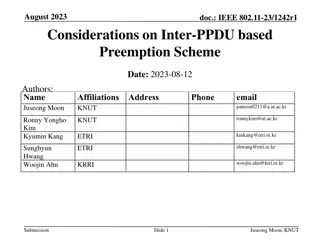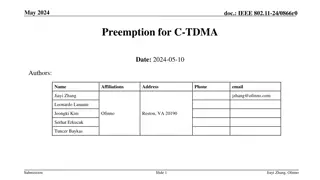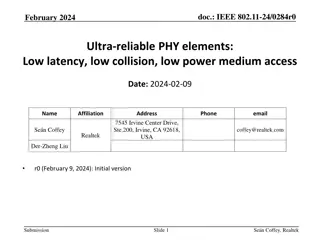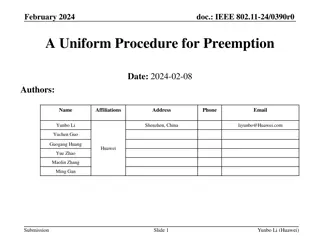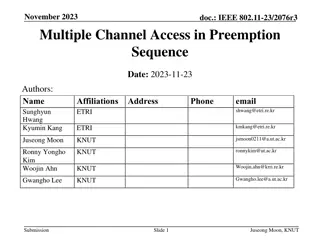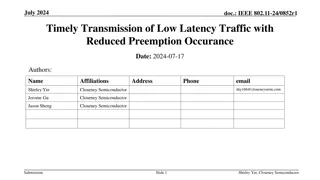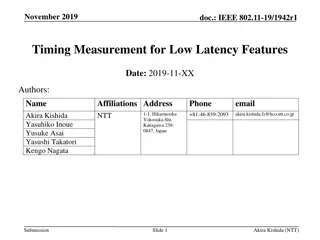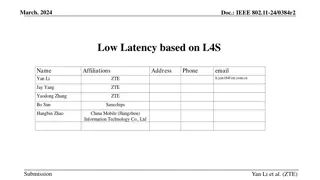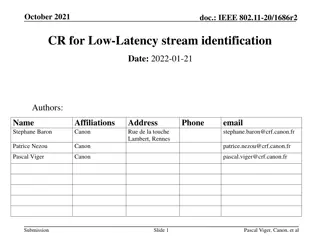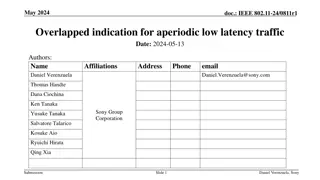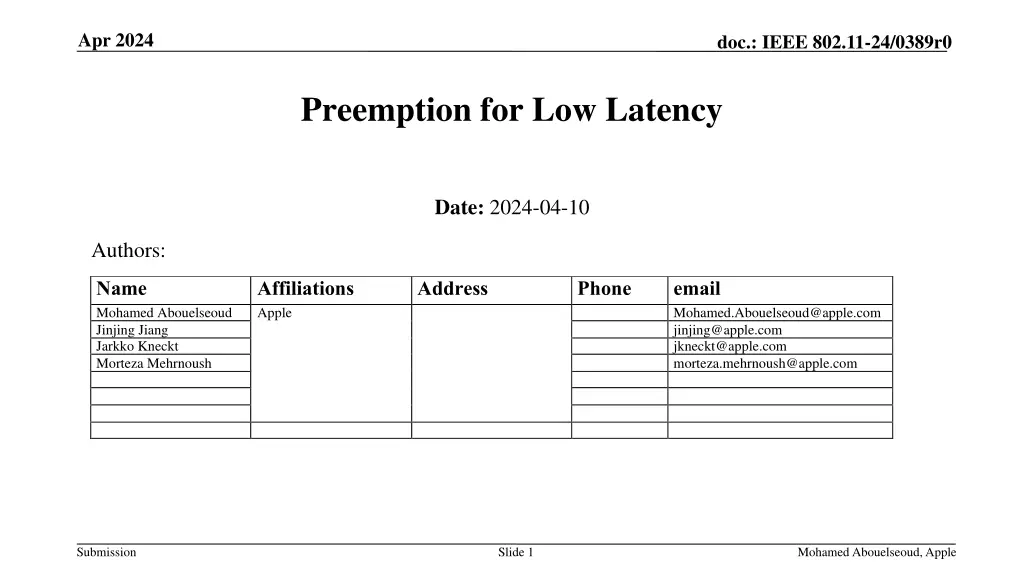
IEEE 802.11-24/0389r0 Preemption for Low Latency in UHR Devices
Explore the IEEE 802.11-24/0389r0 document discussing preemption for reducing latency distribution tails in UHR devices with latency-sensitive applications. The content covers challenges, problem statements, solutions, and the concept of revisiting preemption to optimize channel access and efficiency.
Download Presentation

Please find below an Image/Link to download the presentation.
The content on the website is provided AS IS for your information and personal use only. It may not be sold, licensed, or shared on other websites without obtaining consent from the author. If you encounter any issues during the download, it is possible that the publisher has removed the file from their server.
You are allowed to download the files provided on this website for personal or commercial use, subject to the condition that they are used lawfully. All files are the property of their respective owners.
The content on the website is provided AS IS for your information and personal use only. It may not be sold, licensed, or shared on other websites without obtaining consent from the author.
E N D
Presentation Transcript
Apr 2024 doc.: IEEE 802.11-24/0389r0 Preemption for Low Latency Date: 2024-04-10 Authors: Name Mohamed Abouelseoud Jinjing Jiang Jarkko Kneckt Morteza Mehrnoush Affiliations Apple Address Phone email Mohamed.Abouelseoud@apple.com jinjing@apple.com jkneckt@apple.com morteza.mehrnoush@apple.com Submission Slide 1 Mohamed Abouelseoud, Apple
Apr 2024 doc.: IEEE 802.11-24/0389r0 Introduction Reducing the latency distribution tail in UHR devices with latency sensitive application is one objective of 802.11bn Channel access delay is believed to be the main source of the latency distribution tail Congestion of the channel due to other BSS or OBSS STAs traffic Collision of packets due to increased number of STAs and the exponential backoff Long TXOP by some devices blocking the channel for long period of time Large non-low latency PPDU transmission or reception by the the device with pending low latency traffic 802.11 bn is discussing channel access topics that can help with reducing channel access delay like SCA, DSO, M-AP and preemption Submission Slide 2 Mohamed Abouelseoud, Apple
Apr 2024 doc.: IEEE 802.11-24/0389r0 Problem Statement When channel is congested or blocked by other BSS or OBSS STAs TXOP STA with low latency traffic can use a different link (or sub-channel) When a STA with low latency (LL) traffic is engaged in transmitting or receiving non-low latency traffic, it must wait for the TXOP to terminate to contend for channel access A solution should cover the following use cases: STA while transmitting non-LL traffic needs to transmit LL traffic STA while receiving non-LL traffic needs to transmit LL traffic STA while transmitting non-LL traffic, the receiver needs to transmit LL traffic to the transmitting STA STA while receiving non-LL traffic, the receiver needs to transmit LL traffic to the transmitting STA Shortening the TXOP limit to enable low latency traffic access affects the medium efficiency Any proposed solution should be scalable and should not degrade legacy performance Mohamed Abouelseoud, Apple Submission Slide 3
Apr 2024 doc.: IEEE 802.11-24/0389r0 Revisiting Preemption Preemption is a method to STOP the current ongoing transmission and START transmitting low latency traffic such that the delay bound could be met in time. Problems: Shall we allow to STOP all types of traffic in case of a preemption intent? Who can START: TXOP Holder, TXOP responder, a 3rd Party STA? Submission Slide 4 Jinjing Jiang, Apple Inc.
Apr 2024 doc.: IEEE 802.11-24/0389r0 Preemptable Traffic Types VO or VI traffic should not be preempted due to its inherent requirement on delay bound However, the Internet today has evolved to prefer the majority or all traffic to have low latency Say, loading webpage as quickly as possible In addition to DSCP bleaching problem, there are also major real-time audio/video applications that mark their traffic as BE The 802.11 MAC layer has no knowledge of incorrect traffic categorization Be Mindful before Preempting BE Traffic! Submission Slide 5 Jinjing Jiang, Apple Inc.
Apr 2024 doc.: IEEE 802.11-24/0389r0 When to Preempt? The TXOP holder or the TXOP responder decides whether to preempt The TXOP holder or the TXOP responder is responsible for the consequences and deems preemption a better choice for THEMSELVES It is better not to allow the problematic 3rd party preemption Regression on the performance of existing applications, especially when the Client is the TXOP holder Concern on abusing the preemption methods No incentive for a STA to allow others to preempt its own traffic without its permission Proposed solutions are complicated and not scalable Submission Slide 6 Jinjing Jiang, Apple Inc.
Apr 2024 doc.: IEEE 802.11-24/0389r0 Proposed Solution When low latency data is expected between a STA and its associated STA, it requests to establish a LL-Session The LL-Session initiator and LL-Session responder agrees to enable preemption STAs exchange LL-Session Setup Request and Response frames to negotiate preemption parameters Any non-LL TXOP in a LL-Session initiated by any of the STAs with active LL-Session follow the LL-Session rules Legacy devices and WiFi-8 devices with no active LL-Session Channel access as usual and performance is not affected Mohamed Abouelseoud, Apple Submission Slide 7
Apr 2024 doc.: IEEE 802.11-24/0389r0 UHR STAs with Active LL-Session Behavior LL and non-LL TXOPs limits for the UHR STAs with active LL-Session follow the legacy STAs TXOP limit The TXOP initiator divides the large PPDU into small PPDUs with target length equals to an agreed-on value at the LL-Session setup when transmitting non-LL traffic, for example 1ms TXOP initiator can preempt its own TXOP to transmit low latency traffic to the TXOP responder or any other STA ( infra or P2P) The TXOP responder sends a response frame after each PPDU with LL traffic indication TXOP responder requests to preempt the on-going TXOP TXOP initiator allows preemption based on the request The TXOP initiator always in control whether to share the TXOP or not TXOP initiator reject the request by continuing bursting Submission Slide 8 Mohamed Abouelseoud, Apple
Apr 2024 doc.: IEEE 802.11-24/0389r0 UHR STAs Preemption Requests and Responses TXOP responder sends LL traffic indication to the TXOP initiator in a control response frame to request preemption, example requests: Request to transmit LL traffic to the TXOP initiator in the same TXOP (ex:LL= 1) Request to transmit LL traffic to a STA that is not the TXOP initiator in the same TXOP (ex: LL=2) Request to disengage from current TXOP (ex: LL=3) No request available (ex: LL=0) TXOP initiator responds to the TXOP responder request through Sharing the TXOP with the TXOP responder Continue bursting to the TXOP responder Stopping traffic to this STA in the current TXOP Terminating the TXOP TXOP initiator shall accept the reverse traffic from the TXOP responder in an active LL-Session Once the TXOP responder finishes using the TXOP, it may send a control frame to return the TXOP to the TXOP initiator The TXOP initiator can use the LL indication for future scheduling decision Submission Slide 9 Mohamed Abouelseoud, Apple
Apr 2024 doc.: IEEE 802.11-24/0389r0 DL Preemption Examples AP bursts DL frames to the UHR STA with active LL-Session Target STA can send a preemption request in the PPDU response frame to indicate pending LL traffic AP can share the TXOP with the TXOP responder to send its LL traffic to the AP Submission Slide 10 Mohamed Abouelseoud, Apple
Apr 2024 doc.: IEEE 802.11-24/0389r0 UL Preemption Examples A UHR with active LL-Session STA bursts UL frames to a UHR AP AP can send a preemption request in the PPDU response frame to indicate pending LL traffic to the TXOP initiator STA can share the TXOP with the AP to send its LL traffic to the TXOP initiator AP can send a preemption request in the PPDU response frame to indicate pending LL traffic to a STA other than the TXOP initiator STA can share the TXOP with the AP to send its LL traffic to another STA Submission Slide 11 Mohamed Abouelseoud, Apple
Apr 2024 doc.: IEEE 802.11-24/0389r0 TXOP Disengagement Examples A UHR STA with active LL-Session can request to disengage from the current TXOP from the TXOP initiator The TXOP initiator can accept the request and continue the TXOP with other STAs The TXOP initiator can terminate the current TXOP Submission Slide 12 Mohamed Abouelseoud, Apple
Apr 2024 doc.: IEEE 802.11-24/0389r0 TXOP Preemption at the Beginning of the TXOP A STA ( AP or non-AP STA) can enable preemption at the beginning of the TXOP by soliciting a BA with Preemption Indication at the beginning of the TXOP Example: The STA can send a BAR at the beginning of the TXOP to solicit a BA with LL indication The STA can send a QoS Null to solicit a BA with LL indication The STA can decide to continue with the TXOP or share the TXOP with the TXOP responder Submission Slide 13 Mohamed Abouelseoud, Apple
xxx 2023 doc.: IEEE 802.11-24/0389r0 Summary TXOP preemption can be enabled when needed to enable the TXOP initiator and the TXOP responder to preempt on-going TXOPs The TXOP responder sends preemption request to the TXOP initiator The TXOP initiator shares the TXOP with the TXOP responder when allowed based on the preemption request Submission Slide 14 Mohamed Abouelseoud, Apple


